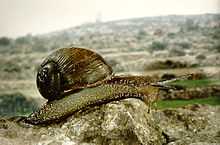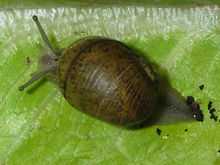Helix aperta
| Helix aperta | |
|---|---|
 | |
| Helix aperta | |
| Conservation status | |
| NE[1] | |
| Scientific classification | |
| Kingdom: | Animalia |
| Phylum: | Mollusca |
| Class: | Gastropoda |
| (unranked): | clade Heterobranchia clade Euthyneura |
| Superfamily: | Helicoidea |
| Family: | Helicidae |
| Genus: | Helix |
| Species: | H. aperta |
| Binomial name | |
| Helix aperta Born, 1778[2] | |
| Synonyms | |
|
Cantareus apertus | |
Helix aperta, also known as Cantareus apertus,[3] and commonly known as the green garden snail, is a species of air-breathing land snail, a terrestrial pulmonate gastropod mollusk in the family Helicidae, the typical snails.
Distribution
Helix aperta is native to Europe primarily near the Mediterranean Sea, and also North Africa.
Distribution of Helix aperta include:
- France west of Rhone estuary[4] It is protected in France, must not be collected for commercial purposes.[4]
- islands in Tyrrhenian Sea[4]
- Italy, Italian peninsula to Liguria and Romagna[4]
- Ionian islands
- central Greece[4]
- Aegean islands[4]
- Cyprus (only one locality)[4]
- Mediterranean north Africa[4]
In Salento it is known as municeḍḍe and in Sicily as attuppateḍḍu.
It has also been introduced to other areas, including Australia:
- It has become established in California and Louisiana.
- Western Australia - nonindegenous[5]
This species is already established in the USA, and is considered to represent a potentially serious threat as a pest, an invasive species which could negatively affect agriculture, natural ecosystems, human health or commerce. Therefore it has been suggested that this species be given top national quarantine significance in the USA.[6]

Description
The shell is with periostracum of green olive colour.[4] The last whorl is much larger than the others.[4]
Width of the shell is 22–28 mm.[4] Height of the shell is also 22–28 mm.[4]
Ecology
Helix aperta inhabits Mediterranean shrublands, near cultivated fields, gardens.[4] In Gavdos (Greece) also in woodland spreading on recently abandoned cultivated fields, more rarely in natural habitats.[4]
In Crete it is active for 3–4 months after the first rainfalls in October, aestivates buried relatively deep in the soil.[4] In hot, dry weather, it burrows three to six inches into the ground and becomes dormant until rain softens the soil. White convex epiphragm is built for aestivation.[4] The living snail gives a characteristic noise when disturbed.[4]
This species of snail makes and uses love darts.
References
This article incorporates public domain text from the reference.[4]
- ↑ 2006 IUCN Red List of Threatened Species. <www.iucnredlist.org>. Cited 8 May 2007.
- ↑ Born I. (1778). Index rerum naturalium Musei Caesarei Vindobonensis. Pars I.ma. Testacea. Verzeichniß der natürlichen Seltenheiten des k. k. Naturalien Cabinets zu Wien. Erster Theil. Schalthiere. pp. [1-40], 1-458, [1-82]. Vindobonae.
- ↑ For those who regard Cornu as available and who classify Helix aperta and Helix aspersa in the same genus and do not like to use Helix for them, the name should be Cornu apertum, but this combination has very rarely been used.
- ↑ 4.0 4.1 4.2 4.3 4.4 4.5 4.6 4.7 4.8 4.9 4.10 4.11 4.12 4.13 4.14 4.15 4.16 4.17 "Species summary for Helix aperta". AnimalBase, last modified 24 January 2010, accessed 13 October 2010.
- ↑ 2. Helix aperta (Born)
- ↑ Cowie R. H., Dillon R. T., Robinson D. G. & Smith J. W. (2009). "Alien non-marine snails and slugs of priority quarantine importance in the United States: A preliminary risk assessment". American Malacological Bulletin 27: 113-132. PDF.
External links
| Wikimedia Commons has media related to Cantareus apertus. |